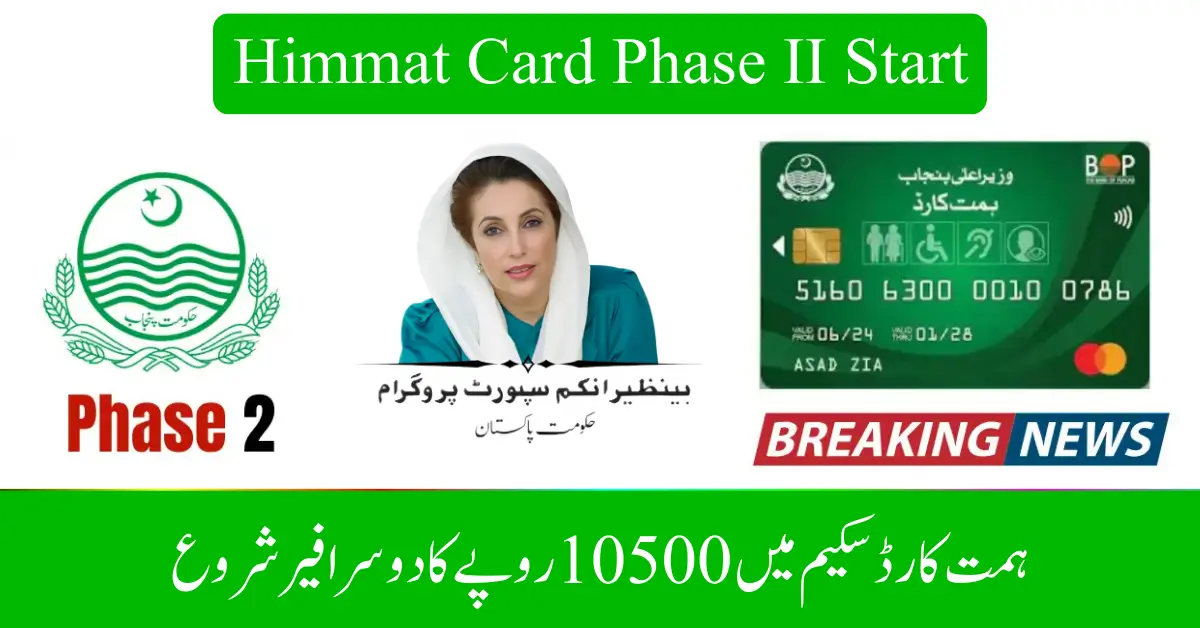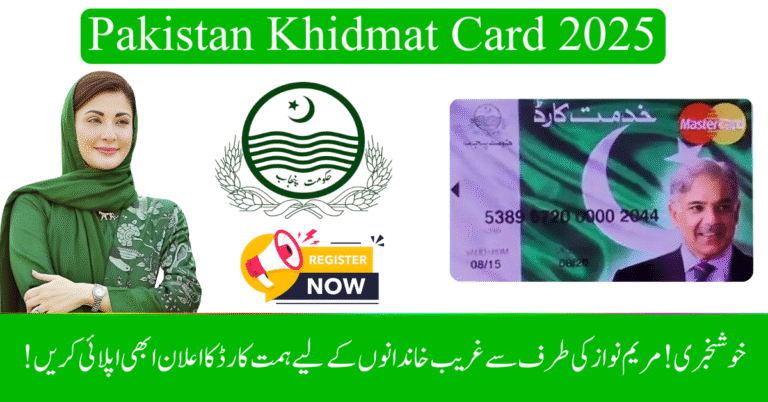Punjab Himmat Card Phase II 2025 – CM Maryam Nawaz’s Rs 10,500 Aid for 25,000 Disabled Citizens
The Punjab government has launched the Himmat Card Phase II 2025, under which Chief Minister Maryam Nawaz has announced Rs 10,500 monthly financial support for 25,000 registered Persons with Disabilities (PWDs). This initiative aims to empower differently-abled individuals by providing consistent financial assistance and ensuring their inclusion in mainstream society.
یہ سکیم حکومت پنجاب کی جانب سے خصوصی افراد کے لئے ایک اہم اقدام ہے۔ وزیراعلیٰ پنجاب مریم نواز نے اس بات کا اعلان کیا کہ ہمت کارڈ فیز ٹو کے تحت 25 ہزار معذور افراد کو 10 ہزار 500 روپے کی مالی امداد فراہم کی جائے گی۔ اس اقدام کا مقصد ان کی زندگیوں میں بہتری اور معاشی سہولت فراہم کرنا ہے تاکہ وہ معاشرے میں باوقار طریقے سے زندگی گزار سکیں۔
Background of Himmat Card Initiative
The Himmat Card Scheme was first introduced to extend financial support, medical aid, and special facilities to disabled citizens of Punjab. Under Phase I, thousands of PWDs benefited through cash stipends, health facilities, and assistive devices.
With the announcement of Phase II in September 2025, the program is being expanded to cover more beneficiaries with increased financial support. The Rs 10,500 aid will help families struggling with medical expenses, education needs, and day-to-day living costs.
Key Features of Himmat Card Phase II 2025
Financial Assistance
-
Each eligible PWD will receive Rs 10,500 per month.
-
Payments will be made through bank accounts or designated payment centers.
Target Beneficiaries
-
25,000 registered persons with disabilities in Punjab.
-
Beneficiaries already registered with Punjab Social Protection Authority (PSPA).
Long-Term Benefits
-
Reduce poverty among disabled families.
-
Improve access to healthcare, education, and rehabilitation services.
-
Encourage social inclusion of PWDs.
Registration Process for Himmat Card Phase II
Step 1: Online Application
-
Visit the official Punjab Social Protection Authority (PSPA) website.
-
Fill in the required details: CNIC, disability certificate, address, and income details.
Step 2: Verification
-
The government will verify information through NADRA and district social welfare offices.
Step 3: Approval
-
Once verified, applicants will receive confirmation and Himmat Card issuance.
Step 4: Monthly Disbursement
-
Beneficiaries will start receiving Rs 10,500 financial aid directly in their accounts.
Eligibility Criteria
To qualify for the Himmat Card Phase II 2025, applicants must:
-
Be a resident of Punjab.
-
Possess a valid CNIC.
-
Have a disability certificate verified by the Social Welfare Department.
-
Belong to a low-income household as per government records.
Documents Required
-
CNIC of applicant.
-
Disability certificate.
-
Proof of residence (utility bill or domicile).
-
Income details (if available).
CM Maryam Nawaz’s Vision for Inclusive Punjab
Maryam Nawaz has emphasized that the Punjab government’s mission is to create a fair and inclusive society where no citizen is left behind due to physical limitations. She stated that initiatives like the Himmat Card Phase II will not only provide financial aid but also bring self-respect and dignity to persons with disabilities.
She also announced future plans including:
-
Special education scholarships for disabled students.
-
Free healthcare facilities in government hospitals.
-
Provision of assistive devices such as wheelchairs and hearing aids.
Impact of Himmat Card Phase II on Disabled Community
Economic Relief
The Rs 10,500 monthly aid will serve as a safety net for many households struggling with rising expenses.
Social Inclusion
PWDs often face discrimination and neglect in society. Financial stability will give them the confidence to participate actively in community life.
Healthcare & Education
Funds can be used to cover medical treatments, rehabilitation, and children’s education.
Challenges in Implementation
Although the initiative is commendable, there are challenges that the government needs to address:
-
Ensuring transparency in beneficiary selection.
-
Preventing fraudulent registrations.
-
Guaranteeing timely payments.
-
Expanding outreach to rural areas where many disabled citizens remain unregistered.
Public Response to Himmat Card Phase II
The announcement has been welcomed positively across Punjab. Civil society groups, NGOs working for disabled rights, and families of PWDs have praised the Rs 10,500 support. However, many have urged the government to expand the program to more beneficiaries, as the current 25,000 quota may not be sufficient considering the population size.
How to Check Himmat Card Payment Status
Beneficiaries can easily check their payment status through the following methods:
-
PSPA official portal by entering CNIC.
-
Helpline number issued by Punjab Social Protection Authority.
-
Visiting nearest bank/payment center.
Future Expansion Plans
The Punjab government is also considering:
-
Expanding the scheme to 50,000 beneficiaries by 2026.
-
Introducing interest-free loans for disabled entrepreneurs.
-
Building special rehabilitation centers in all districts.
Why Himmat Card Matters in September 2025 Context
With economic challenges, inflation, and rising cost of living in Pakistan, initiatives like the Himmat Card Phase II 2025 are a ray of hope for many struggling families. The scheme reflects the government’s commitment towards welfare and inclusion, particularly in September when new policies are being introduced to stabilize the economy.
Conclusion
The launch of Himmat Card Phase II 2025 by CM Maryam Nawaz is a landmark initiative for the welfare of Persons with Disabilities in Punjab. With Rs 10,500 monthly support for 25,000 beneficiaries, the program not only ensures financial relief but also aims to bring dignity, inclusion, and hope for differently-abled citizens.
If implemented with transparency and efficiency, the Himmat Card Scheme has the potential to become a model welfare program for other provinces as well.





